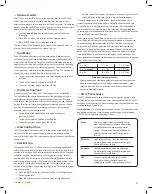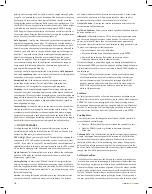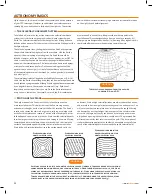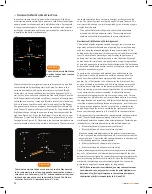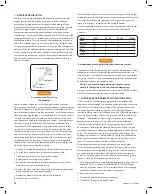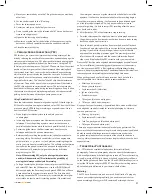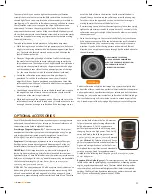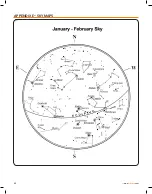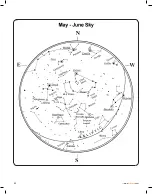
>>
www
.celestron
.com
27
5 . Mount your camera body onto the T-Ring the same as you would any
other lens .
6. Set the shutter speed to the “B” setting.
7. Focus the telescope on a star.
8. Center your subject in the field of your camera.
9. Find a suitable guide star in the telescope field. This can be the most
time consuming process .
10. Open the shutter using a cable release.
11 . Monitor your guide star for the duration of the exposure using the
buttons on the hand controller to make the needed corrections .
12 . Close the camera’s shutter .
>>
Periodic Error Correction (PEC)
PEC for short, is a system that improves the tracking accuracy of the
drive by reducing the number of user corrections needed to keep a guide
star centered in the eyepiece . PEC is designed to improve photographic
quality by reducing the amplitude of the worm errors . Using the PEC
function is a three-step process. First, the CPC needs to know the current
position of its worm gear so that it has a reference when playing back
the recorded error . Next, you must guide for at least 8 minutes during
which time the system records the correction you make. (It takes the
worm gear 8 minutes to make one complete revolution, hence the need
to guide for 8 minutes) . This “teaches” the PEC chip the characteristics
of the worm . The periodic error of the worm gear drive will be stored in
the PEC chip and used to correct periodic error . The last step is to play
back the corrections you made during the recording phase. Keep in mind,
this feature is for advanced astrophotography and still requires careful
guiding since all telescope drives have some periodic error .
Using Periodic Error Correction
Once the telescope has been polar aligned using the EQ North Align (or
EQ South for southern hemisphere) method, select PEC from the Utilities
menu and press ENTER to begin recording your periodic error . Here’s
how to use the PEC function .
1. Find a bright star relatively close to the object you want
to photograph .
2. Insert a high power eyepiece with illuminated cross hairs into your
telescope. Orient the guiding eyepiece cross hairs so that one is
parallel to the declination while the other is parallel to the R .A . axis .
3 . Center the guide star on the illuminated cross hairs, focus the
telescope and study the periodic movement .
4 . Before actually recording the periodic error, take a few minutes to
practice guiding . Set the hand control slew rate to an appropriate
guide rate (rate 1 = .5x, rate 2 = 1x) and practice centering the guide
star in the cross hairs for several minutes . This will help you familiarize
yourself with the periodic error of the drive and the operation of
the hand control . Remember to ignore declination drift when
programming the PEC .
Note: When recording PEC, only the photo guide rates (rates
1 and 2) will be operational. This eliminates the possibility of
moving the telescope suddenly while recording.
5 . To begin recording the drive’s periodic error, press the MENU button
and select PEC from the Utilities menu. Use the UP/DOWN scroll
buttons to display the Record option and press ENTER . You will have
5 seconds before the system starts to record. The first time each
observing session that PEC record or play is selected, the worm gear
must rotate in order to mark its starting position. If the rotation of
the worm gear moves your guide star outside the field of view of the
eyepiece, it will have to be re-centered before the recording begins .
Once the worm gear is indexed, it will not need to be positioned again
until the telescope is turned-off. So, to give yourself more time to
prepare for guiding, it is best to restart PEC recording after the worm
gear has found its index .
6. After 8 minutes, PEC will automatically stop recording.
7. Point the telescope at the object you want to photograph and center
the guide star on the illuminated cross hairs and you are ready to play
back the periodic error correction .
8. Once the drive’s periodic error has been recorded, use the Playback
function to begin playing back the correction for future photographic
guiding. If you want to re-record the periodic error, select Record
and repeat the recording processes again . The previously recorded
information will be replaced with the current information . Repeat
steps 7 and 8 to playback the PEC corrections for your next object.
Does the PEC function make unguided astrophotography possible? Yes and
no. For solar (filtered), lunar and piggyback (up to 200 mm), the answer is
yes. However, even with PEC, off-axis guiding is still mandatory for long
exposure, deep sky astrophotography . The optional Reducer/Corrector lens
reduces exposure times making the task of guiding a little easier .
When getting started, use fast films to record as much detail in the
shortest possible time . Here are proven recommendations:
• Ektar 1000 (color print)
• Konica 3200 (color print)
• Fujichrome 1600D (color slide)
• 3M 1000 (color slide)
• Scotchchrome 400
• T-Max 3200 (black and white print)
• T-Max 400 (black and white print)
As you perfect your technique, try specialized films, which are films that
are designed or specially treated for celestial photography . Here are
some popular choices:
• Ektar 125 (color print)
• Fujichrome 100D (color slide)
• Tech Pan, gas hypered (black and white print)
• T-Max 400 (black and white print)
There is no exposure determination table to help you get started . The
best ways to determine exposure length is to look at previously published
photos to see what film/exposure combinations were used or take
unguided sample photos of various parts of the sky while the drive is
running . Always take exposures of various lengths to determine the best
exposure time .
>>
Terrestrial Photography
Your CPC makes an excellent telephoto lens for terrestrial (land)
photography . Terrestrial photography is best done with the telescope in
Alt-Az configuration and the tracking drive turned off. To turn the tracking
drive off, press the MENU (9) button on the hand control and scroll down
to the Tracking Mode sub menu. Use the UP and DOWN scroll keys (10) to
select the Off option and press ENTER. This will turn the tracking motors
off so that objects will remain in your camera’s field of view.
Metering
The CPC has a fixed aperture, and as a result, fixed f/ratios. To properly
expose your subjects photographically, you need to set your shutter
speed accordingly. Most 35 mm SLR cameras offer through-the-lens
Summary of Contents for 11007
Page 1: ...InstructionManual 11007 11008 11009...
Page 2: ...www celestron com...
Page 40: ...38 www celestron com APPENDIXD MAPSOFTIMEZONES...
Page 41: ...www celestron com 39...
Page 42: ...40 www celestron com APPENDIXE SKYMAPS...
Page 43: ...www celestron com 41...
Page 44: ...42 www celestron com...
Page 45: ...www celestron com 43...
Page 46: ...44 www celestron com...
Page 47: ...www celestron com 45...

